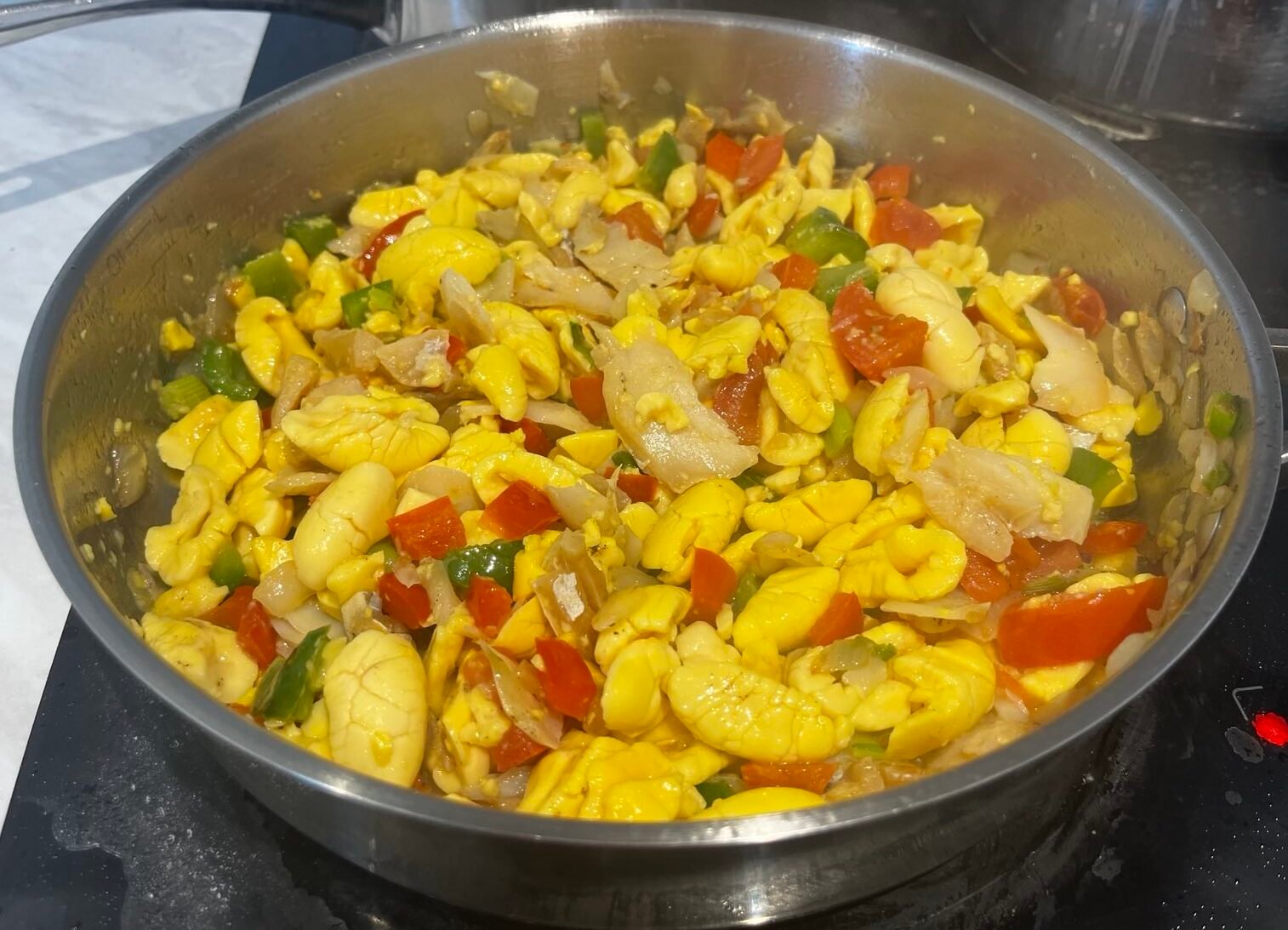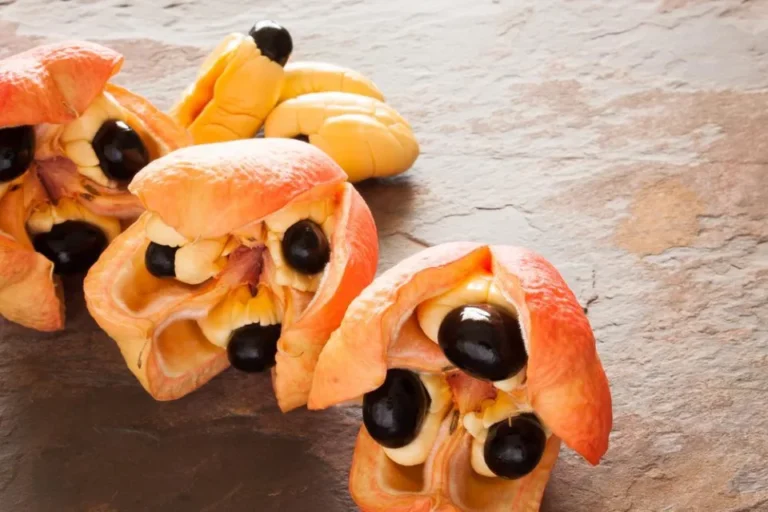What Does Ackee Taste Like?
Ackee often sparks curiosity due to its unique characteristics and widespread popularity in Jamaican cuisine.
Ackee is Jamaica’s national fruit, while ackee and saltfish is Jamaica’s national dish.
One of the most common questions people have is: What does ackee taste like?
In this article, the distinct flavor of ackee will be explored to provide a deeper understanding and appreciation of why this delicious fruit holds such a cherished place in Jamaican culinary traditions.
Describing the Taste of Ackee
Ackee has a mild, nutty, and buttery flavor with a creamy and smooth texture. While it looks like scrambled eggs when cooked, it’s important to note that ackee does not taste like eggs.
Ackee readily absorbs the flavors of the spices and ingredients it’s cooked with, making it a versatile and integral part of many dishes.
Its taste is difficult to describe—you really have to try it to understand its unique, subtle flavor. One thing is certain: ackee is delicious!
Here is a first a firsthand account of someone trying ackee for the first time:
I first tried ackee and saltfish in Jamaica while I was on a family vacation in Montego Bay. I had never tried it before but had heard a lot about it over the years. The colorful sight of the yellow fruit mixed with peppers and saltfish (salted codfish) really had me excited. I didn’t know what to expect—it resembled scrambled eggs, but my family member who prepared it assured me that it didn’t taste like eggs. When I took my first bite, I was amazed. The combination of soft and firm textures, along with the salty and buttery flavors, danced in my mouth and instantly won me over. It was mouthwatering and unforgettable.
With that out of the way, let’s take a closer look at the taste of ackee:
What Does Canned Ackee Taste Like?
Canned ackee has the same mild, nutty, and buttery flavor as fresh ackee, making it a convenient option for those who want to enjoy this unique fruit.
Canned ackee can be easily purchased in many international grocery stores, particularly those specializing in Caribbean foods.
This convenience allows people around the world to experience and appreciate the delicious taste of ackee.
The Taste Profile of Ackee
This section delves into the flavor characteristics, comparisons to other foods, and its unique texture.
General Flavor Characteristics
Ackee has a mild, nutty, and buttery flavor. Its taste is subtle yet distinctive, offering a pleasant, creamy richness that complements a variety of ingredients. Unlike more potent fruits, ackee’s flavor is understated, allowing it to blend harmoniously with spices and other components in a dish.
Texture and Mouthfeel of Ackee
When cooked, ackee has a creamy and soft texture.
This texture is soft yet firm enough to hold its shape in dishes, providing a delightful mouthfeel that is both satisfying and versatile.
Comparing the Taste of Ackee to Other Foods
Ackee is often compared to scrambled eggs due to its creamy and mild flavor. This comparison comes from the way ackee looks when cooked, which can resemble scrambled eggs. However, ackee doesn’t taste like eggs.
Some people also compare its taste to that of avocado, but ackee is less oily and has a more subtle flavor.
Some also say that the flavor of ackee can be likened to that of a mild, slightly nutty vegetable like zucchini or chayote. Jamaicans would disagree.
Ackee has its own unique taste that sets it apart.
How Is Ackee Eaten?
Ackee is a versatile fruit that can be enjoyed both fresh and canned. Here’s how ackee is eaten in both forms:
Fresh Ackee
Preparation
- Fresh ackee must be properly prepared before eating. First, ensure the fruit is fully ripe and has naturally opened on the tree to reveal the yellow flesh and black seeds.
- Remove the yellow flesh, discarding the seeds and any pinkish membrane attached to the flesh.
- Rinse the ackee thoroughly under running water to remove any debris or toxins.
Cooking
- Fresh ackee is typically boiled in water for about 10-15 minutes until tender.
- After boiling, drain the ackee and it is ready to be used in various dishes.
- Fresh ackee is commonly sautéed with onions, tomatoes, bell peppers, and spices such as thyme and black pepper. This preparation is often used in the iconic Jamaican dish, ackee and saltfish.
- It can also be mixed into vegetarian dishes, stews, or used as a creamy addition to various recipes.
Canned Ackee
Preparation
- Canned ackee is already cooked and ready to use, making it convenient and quick to prepare.
- Carefully drain the liquid from the can and gently rinse the ackee to remove any excess brine.
Cooking
- Because canned ackee is softer in texture, handle it gently during cooking to maintain its structure.
- It can be sautéed with the same ingredients as fresh ackee: onions, tomatoes, bell peppers, and spices.
- Canned ackee can also be used in a variety of dishes, such as ackee and saltfish, vegetarian meals, or even as a creamy addition to fusion cuisine.
Ackee in Jamaican Dishes
Ackee is a staple in Jamaican cuisine, celebrated for its versatility and unique flavor. Here’s a look at how ackee is used in various Jamaican dishes:
Ackee and Saltfish
- Taste Combination
Ackee and saltfish is a delightful blend of flavors and textures. The mild, buttery ackee pairs perfectly with the salty, savory taste of the saltfish (salted cod). This combination creates a rich, mouthwatering dish that is both satisfying and flavorful.
- Other Common Ingredients
In addition to ackee and saltfish, the dish typically includes onions, tomatoes, bell peppers, and Scotch bonnet peppers. These ingredients add layers of flavor and a hint of heat, enhancing the overall taste experience. Seasonings like thyme and black pepper are often used to bring out the best in the dish.
Ackee in Other Recipes
- Soups
Ackee can be used in soups to add a creamy texture and subtle flavor. It pairs well with various vegetables and proteins, making it a versatile addition to hearty, comforting soups.
- Vegetarian Dishes
Ackee is an excellent ingredient in vegetarian dishes, providing a creamy, buttery element that enhances the flavor of vegetables and grains. It can be used in stir-fries, casseroles, and salads, offering a unique taste and texture.
- Fusion Cuisine
Ackee’s unique flavor and texture make it a great addition to fusion cuisine. It can be incorporated into pasta dishes, pizzas, and even tacos, blending Jamaican flavors with other culinary traditions to create exciting, innovative dishes.
Common Side Dishes and Beverages
Ackee is often served with traditional Jamaican side dishes such as fried dumplings, breadfruit, and rice and peas.
These sides complement the creamy texture and subtle flavor of ackee, creating a well-rounded meal.
For beverages, ackee pairs nicely with tropical drinks like sorrel, ginger beer, or a refreshing glass of coconut water, all of which enhance the dining experience with their distinct, vibrant flavors.
Where Can I Taste Ackee?
1. In Jamaica
Local Restaurants and Street Vendors
- For an authentic experience, try ackee dishes at local Jamaican restaurants and street vendors. They often serve traditional dishes like ackee and saltfish, giving you a true taste of how ackee is enjoyed in its native setting.
- Popular locations include Ocho Rios, Kingston, Montego Bay, and Negril, where local eateries pride themselves on serving authentic Jamaican cuisine.
Food Festivals and Events
- Attending food festivals and events in Jamaica is another excellent way to taste ackee. Events like the Jamaica Food & Drink Festival showcase traditional and innovative uses of ackee, allowing you to explore its versatility.
2. Outside Jamaica
Caribbean Restaurants
- Many Caribbean restaurants around the world, especially in cities with large Caribbean communities, serve dishes featuring ackee. Look for Jamaican or Caribbean eateries in cities like New York, London, Toronto, and Miami.
- These restaurants often include ackee and saltfish on their menus, providing a taste of Jamaican cuisine.
Specialty Food Stores and Markets
- Specialty food stores and markets that cater to Caribbean communities often sell canned ackee. This allows you to purchase ackee and try cooking it at home.
- Look for stores that import Caribbean foods, or check online retailers that offer international grocery items.
Cultural and Food Festivals
- Cultural and food festivals celebrating Caribbean heritage frequently feature ackee dishes. These events can be found in major cities worldwide and offer a chance to sample traditional and modern ackee recipes.
- Events like the Caribbean Carnival in Toronto or the Notting Hill Carnival in London often have food stalls serving authentic Jamaican dishes.
By exploring these various options, you can experience the unique taste of ackee whether you’re in Jamaica or elsewhere around the world.
What Does Ackee Taste Like? Conclusion
Ackee has a mild, nutty, and buttery flavor with a creamy and smooth texture. Although it resembles scrambled eggs in appearance when cooked, it does not taste like eggs. Its unique taste sets it apart, making it a key ingredient in many traditional Jamaican dishes.
Whether fresh or canned, ackee offers a delightful culinary experience. It pairs well with a variety of spices, vegetables, and proteins, making it a versatile addition to numerous dishes. Ackee is delicious in many recipes, such as the classic ackee and saltfish, soups, vegetarian meals, and fusion cuisine.
Ackee holds a cherished place in Jamaican cuisine and culture, symbolizing the island’s rich culinary heritage. As more people around the world discover its delicious and distinctive taste, ackee is gradually making its mark in global cuisine. Its versatility and unique flavor make it a valuable ingredient, capable of enhancing a wide range of dishes and delighting taste buds everywhere.




